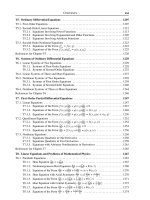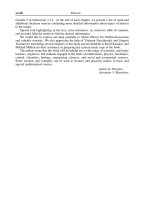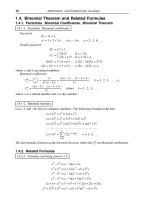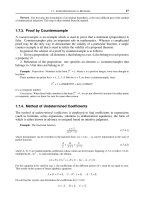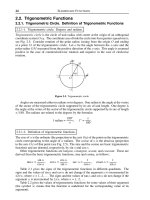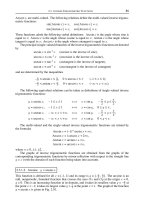Handbook of mathematics for engineers and scienteists part 104 ppsx
Bạn đang xem bản rút gọn của tài liệu. Xem và tải ngay bản đầy đủ của tài liệu tại đây (457.5 KB, 7 trang )
15.5. METHOD OF GENERALIZED SEPARATION OF VARIABLES 689
2
◦
. At the second stage, we successively substitute the Φ
i
(X)andΨ
j
(Y ) of (15.5.1.4)
into all solutions (15.5.4.1) to obtain systems of ordinary differential equations* for the
unknown functions ϕ
p
(x)andψ
q
(y). Solving these systems, we get generalized separable
solutions of the form (15.5.1.1).
Remark 1. It is important that, for fixed k, the bilinear functional equation (15.5.1.3) used in the splitting
method is the same for different classes of original nonlinear mathematical physics equations.
Remark 2. For fixed m, solution (15.5.4.1) contains m(k – m) arbitrary constants C
i,j
.Givenk,the
solutions having the maximum number of arbitrary constants are defined by
Solution number Number of arbitrary constants Conditions on k
m =
1
2
k
1
4
k
2
if k is even,
m =
1
2
(k 1)
1
4
(k
2
– 1)ifk is odd.
It is these solutions of the bilinear functional equation that most frequently result in nontrivial generalized
separable solution in nonlinear partial differential equations.
Remark 3. The bilinear functional equation (15.5.1.3) and its solutions (15.5.4.1) play an important role
in the method of functional separation of variables.
For visualization, the main stages of constructing generalized separable solutions by the
splitting method are displayed in Fig. 15.2.
15.5.4-2. Solutions of simple functional equations and their application.
Below we give solutions to two simple bilinear functional equations of the form (15.5.1.3)
that will be used subsequently for solving specific nonlinear partial differential equations.
1
◦
. The functional equation
Φ
1
Ψ
1
+ Φ
2
Ψ
2
+ Φ
3
Ψ
3
= 0,(15.5.4.2)
where Φ
i
are all functions of thesame argument and Ψ
i
are all functions of anotherargument,
has two solutions:
Φ
1
= A
1
Φ
3
, Φ
2
= A
2
Φ
3
, Ψ
3
=–A
1
Ψ
1
– A
2
Ψ
2
;
Ψ
1
= A
1
Ψ
3
, Ψ
2
= A
2
Ψ
3
, Φ
3
=–A
1
Φ
1
– A
2
Φ
2
.
(15.5.4.3)
The arbitrary constants are renamed as follows: A
1
= C
1,1
and A
2
= C
2,1
in the first solution,
and A
1
=–1/C
1,2
and A
2
= C
1,1
/C
1,2
in the second solution. The functions on the right-hand
sides of the formulas in (15.5.4.3) are assumed to be arbitrary.
2
◦
. The functional equation
Φ
1
Ψ
1
+ Φ
2
Ψ
2
+ Φ
3
Ψ
3
+ Φ
4
Ψ
4
= 0,(15.5.4.4)
where Φ
i
are all functions of thesame argument and Ψ
i
are all functions of anotherargument,
has a solution
Φ
1
= A
1
Φ
3
+ A
2
Φ
4
, Φ
2
= A
3
Φ
3
+ A
4
Φ
4
,
Ψ
3
=–A
1
Ψ
1
– A
3
Ψ
2
, Ψ
4
=–A
2
Ψ
1
– A
4
Ψ
2
(15.5.4.5)
dependent on four arbitrary constants A
1
, , A
4
; see solution (15.5.4.1) with k = 4, m = 2,
C
1,1
= A
1
, C
1,2
= A
2
, C
2,1
= A
3
,andC
2,2
= A
4
. The functions on the right-hand sides of
the solutions in (15.5.4.3) are assumed to be arbitrary.
* Such systems are usually overdetermined.
690 NONLINEAR PARTIAL DIFFERENTIAL EQUATIONS
Write out the functional differential equation
Obtain: (i) functional equation, (ii) determining system of ODEs
Solve the determining system of ordinary differential equations
Write out generalized separable solution of original equation
Search for generalized separable solutions
Substitute into original equation
Apply splitting procedure
Treat functional equation (i)
Figure 15.2. General scheme for constructing generalized separable solutions by the splitting method. Abbre-
viation: ODE stands for ordinary differential equation.
Equation (15.5.4.4) also has two other solutions:
Φ
1
= A
1
Φ
4
, Φ
2
= A
2
Φ
4
, Φ
3
= A
3
Φ
4
, Ψ
4
=–A
1
Ψ
1
– A
2
Ψ
2
– A
3
Ψ
3
;
Ψ
1
= A
1
Ψ
4
, Ψ
2
= A
2
Ψ
4
, Ψ
3
= A
3
Ψ
4
, Φ
4
=–A
1
Φ
1
– A
2
Φ
2
– A
3
Φ
3
(15.5.4.6)
involving three arbitrary constants. In the fi rst solution, A
1
= C
1,1
, A
2
= C
2,1
,andA
3
= C
3,1
,
and in the second solution, A
1
=–1/C
1,3
, A
2
= C
1,1
/C
1,3
,andA
3
= C
1,2
/C
1,3
.
Solutions (15.5.4.6) will sometimes be called degenerate, to emphasize the fact that
they contain fewer arbitrary constants than solution (15.5.4.5).
3
◦
. Solutions of the functional equation
Φ
1
Ψ
1
+ Φ
2
Ψ
2
+ Φ
3
Ψ
3
+ Φ
4
Ψ
4
+ Φ
5
Ψ
5
= 0 (15.5.4.7)
can be found by formulas (15.5.4.1) with k = 5. Below is a simple technique for fi nding
solutions, which is quite useful in practice, based on equation (15.5.4.7) itself. Let us
assume that Φ
1
, Φ
2
,andΦ
3
are linear combinations of Φ
4
and Φ
5
:
Φ
1
= A
1
Φ
4
+ B
1
Φ
5
, Φ
2
= A
2
Φ
4
+ B
2
Φ
5
, Φ
3
= A
3
Φ
4
+ B
3
Φ
5
,(15.5.4.8)
15.5. METHOD OF GENERALIZED SEPARATION OF VARIABLES 691
where A
n
, B
n
are arbitrary constants. Let us substitute (15.5.4.8) into (15.5.4.7) and collect
the terms proportional to Φ
4
and Φ
5
to obtain
(A
1
Ψ
1
+ A
2
Ψ
2
+ A
3
Ψ
3
+ Ψ
4
)Φ
4
+(B
1
Ψ
1
+ B
2
Ψ
2
+ B
3
Ψ
3
+ Ψ
5
)Φ
5
= 0.
Equating the expressions in parentheses to zero, we have
Ψ
4
=–A
1
Ψ
1
– A
2
Ψ
2
– A
3
Ψ
3
,
Ψ
5
=–B
1
Ψ
1
– B
2
Ψ
2
– B
3
Ψ
3
.
(15.5.4.9)
Formulas (15.5.4.8) and (15.5.4.9) give solutions to equation (15.5.4.7). Other solutions
are found likewise.
Example 1. Consider the nonlinear hyperbolic equation
∂
2
w
∂t
2
= a
∂
∂x
w
∂w
∂x
+ f(t)w + g(t), (15.5.4.10)
where f(t)andg(t) are arbitrary functions. We look for generalized separable solutions of the form
w(x, t)=ϕ(x)ψ(t)+χ(t). (15.5.4.11)
Substituting (15.5.4.11) into (15.5.4.10) and collecting terms yield
aψ
2
(ϕϕ
x
)
x
+ aψχϕ
xx
+(fψ – ψ
tt
)ϕ + fχ + g – χ
tt
= 0.
This equation can be represented as a functional equation (15.5.4.4) in which
Φ
1
=(ϕϕ
x
)
x
, Φ
2
= ϕ
xx
, Φ
3
= ϕ, Φ
4
= 1,
Ψ
1
= aψ
2
, Ψ
2
= aψχ, Ψ
3
= fψ – ψ
tt
, Ψ
4
= fχ + g – χ
tt
.
(15.5.4.12)
On substituting (15.5.4.12) into (15.5.4.5), we obtain the following overdetermined system of ordinary differ-
ential equations for the functions ϕ = ϕ(x), ψ = ψ(t), and χ = χ(t):
(ϕϕ
x
)
x
= A
1
ϕ + A
2
, ϕ
xx
= A
3
ϕ + A
4
,
fψ – ψ
tt
=–A
1
aψ
2
– A
3
aψχ, fχ+ g – χ
tt
=–A
2
aψ
2
– A
4
aψχ.
(15.5.4.13)
The first two equations in (15.5.4.13) are compatible only if
A
1
= 6B
2
, A
2
= B
2
1
– 4B
0
B
2
, A
3
= 0, A
4
= 2B
2
, (15.5.4.14)
where B
0
, B
1
,andB
2
are arbitrary constants, and the solution is given by
ϕ(x)=B
2
x
2
+ B
1
x + B
0
. (15.5.4.15)
On substituting the expressions (15.5.4.14) into the last two equations in (15.5.4.13), we obtain the following
system of equations for ψ(t)andχ(t):
ψ
tt
= 6aB
2
ψ
2
+ f(t)ψ,
χ
tt
=[2aB
2
ψ + f(t)]χ + a(B
2
1
– 4B
0
B
2
)ψ
2
+ g(t).
(15.5.4.16)
Relations (15.5.4.11), (15.5.4.15) and system (15.5.4.16) determine a generalized separable solution of
equation (15.5.4.10). The first equation in (15.5.4.16) can be solved independently; it is linear if B
2
= 0 and is
integrable by quadrature for f(t) = const. The second equation in (15.5.4.16) is linear in χ (for ψ known).
Equation (15.5.4.10) does not have other solutions with the form (15.5.4.11) if f and g are arbitrary
functions and ϕ
0, ψ 0,andχ 0.
692 NONLINEAR PARTIAL DIFFERENTIAL EQUATIONS
Remark. It can be shown that equation (15.5.4.10) has a more general solution with the form
w(x, y)=ϕ
1
(x)ψ
1
(t)+ϕ
2
(x)ψ
2
(t)+ψ
3
(t), ϕ
1
(x)=x
2
, ϕ
2
(x)=x, (15.5.4.17)
where the functions ψ
i
= ψ
i
(t) are determined by the ordinary differential equations
ψ
1
= 6aψ
2
1
+ f(t)ψ
1
,
ψ
2
=[6aψ
1
+ f(t)]ψ
2
,
ψ
3
=[2aψ
1
+ f(t)]ψ
3
+ aψ
2
2
+ g(t).
(15.5.4.18)
(The prime denotes a derivative with respect to t.) The second equation in (15.5.4.18) has a particular solution
ψ
2
= ψ
1
. Hence, its general solution can be represented as (see Polyanin and Zaitsev, 2003)
ψ
2
= C
1
ψ
1
+ C
2
ψ
1
dt
ψ
2
1
.
The solution obtained in Example 1 corresponds to the special case C
2
= 0.
Example 2. Consider the nonlinear equation
∂
2
w
∂x∂t
+
∂w
∂x
2
– w
∂
2
w
∂x
2
= a
∂
3
w
∂x
3
, (15.5.4.19)
which arises in hydrodynamics (see Polyanin and Zaitsev, 2004).
We look for exact solutions of the form
w = ϕ(t)θ(x)+ψ(t). (15.5.4.20)
Substituting (15.5.4.20) into (15.5.4.19) yields
ϕ
t
θ
x
– ϕψθ
xx
+ ϕ
2
(θ
x
)
2
– θθ
xx
– aϕθ
xxx
= 0.
This functional differential equation can be reduced to the functional equation (15.5.4.4) by setting
Φ
1
= ϕ
t
, Φ
2
= ϕψ, Φ
3
= ϕ
2
, Φ
4
= aϕ,
Ψ
1
= θ
x
, Ψ
2
=–θ
xx
, Ψ
3
=(θ
x
)
2
– θθ
xx
, Ψ
4
=–θ
xxx
.
(15.5.4.21)
On substituting these expressions into (15.5.4.5), we obtain the system of ordinary differential equations
ϕ
t
= A
1
ϕ
2
+ A
2
aϕ, ϕψ = A
3
ϕ
2
+ A
4
aϕ,
(θ
x
)
2
– θθ
xx
=–A
1
θ
x
+ A
3
θ
xx
, θ
xxx
= A
2
θ
x
– A
4
θ
xx
.
(15.5.4.22)
It can be shown that the last two equations in (15.5.4.22) are compatible only if the function θ and its
derivative are linearly dependent,
θ
x
= B
1
θ + B
2
. (15.5.4.23)
The six constants B
1
, B
2
, A
1
, A
2
, A
3
,andA
4
must satisfy the three conditions
B
1
(A
1
+ B
2
– A
3
B
1
)=0,
B
2
(A
1
+ B
2
– A
3
B
1
)=0,
B
2
1
+ A
4
B
1
– A
2
= 0.
(15.5.4.24)
Integrating (15.5.4.23) yields
θ =
B
3
exp(B
1
x)–
B
2
B
1
if B
1
≠ 0,
B
2
x + B
3
if B
1
= 0,
(15.5.4.25)
where B
3
is an arbitrary constant.
The first two equations in (15.5.4.22) lead to the following expressions for ϕ and ψ:
ϕ =
⎧
⎪
⎨
⎪
⎩
A
2
a
C exp(–A
2
at)–A
1
if A
2
≠ 0,
–
1
A
1
t + C
if A
2
= 0,
ψ = A
3
ϕ + A
4
a, (15.5.4.26)
where C is an arbitrary constant.
15.5. METHOD OF GENERALIZED SEPARATION OF VARIABLES 693
Formulas (15.5.4.25), (15.5.4.26) and relations (15.5.4.24) allow us to find the following solutions of
equation (15.5.4.19) with the form (15.5.4.20):
w =
x + C
1
t + C
2
+ C
3
if A
2
= B
1
= 0, B
2
=–A
1
;
w =
C
1
e
–λx
+ 1
λt + C
2
+ aλ if A
2
= 0, B
1
=–A
4
, B
2
=–A
1
– A
3
A
4
;
w = C
1
e
–λ(x+aβt)
+ a(λ + β)ifA
1
= A
3
= B
2
= 0, A
2
= B
2
1
+ A
4
B
1
;
w =
aβ + C
1
e
–λx
1 + C
2
e
–aλβt
+ a(λ – β)ifA
1
= A
3
B
1
– B
2
, A
2
= B
2
1
+ A
4
B
1
,
where C
1
, C
2
, C
3
, β,andλ are arbitrary constants (these can be expressed in terms of the A
k
and B
k
).
The analysis of the second solution (15.5.4.6) of the functional equation (15.5.4.4) in view of (15.5.4.21)
leads to the following two more general solutions of the differential equation (15.5.4.19):
w =
x
t + C
1
+ ψ(t),
w = ϕ(t)e
–λx
–
ϕ
t
(t)
λϕ(t)
+ aλ,
where ϕ(t)andψ(t) are arbitrary functions, and C
1
and λ are arbitrary constants.
15.5.5. Titov–Galaktionov Method
15.5.5-1. Method description. Linear subspaces invariant under a nonlinear operator.
Consider the nonlinear evolution equation
∂w
∂t
= F [w], (15.5.5.1)
where F [w] is a nonlinear differential operator with respect to x,
F [w] ≡ F
x, w,
∂w
∂x
, ,
∂
m
w
∂x
m
.(15.5.5.2)
Definition
.Afinite-dimensional linear subspace
n
=
ϕ
1
(x), , ϕ
n
(x)
(15.5.5.3)
formed by linear combinations of linearly independent functions ϕ
1
(x), , ϕ
n
(x) is called
invariant under the operator F if F [
n
] ⊆
n
. This means that there exist functions
f
1
, , f
n
such that
F
n
i=1
C
i
ϕ
i
(x)
=
n
i=1
f
i
(C
1
, , C
n
)ϕ
i
(x)(15.5.5.4)
for arbitrary constants C
1
, , C
n
.
Let the linear subspace (15.5.5.3) be invariant under the operator F. Then equation
(15.5.5.1) possesses generalized separable solutions of the form
w(x, t)=
n
i=1
ψ
i
(t)ϕ
i
(x). (15.5.5.5)
Here, the functions ψ
1
(t), , ψ
n
(t) are described by the autonomous system of ordinary
differential equations
ψ
i
= f
i
(ψ
1
, , ψ
n
), i = 1, , n,(15.5.5.6)
where the prime denotes a derivative with respect to t.
The following example illustrates the scheme for constructing generalized separable
solutions.
694 NONLINEAR PARTIAL DIFFERENTIAL EQUATIONS
Example 1. Consider the nonlinear second-order parabolic equation
∂w
∂t
= a
∂
2
w
∂x
2
+
∂w
∂x
2
+ kw
2
+ bw + c.(15.5.5.7)
Obviously, the nonlinear differential operator
F [w]=aw
xx
+(w
x
)
2
+ kw
2
+ bw + c (15.5.5.8)
for k > 0 has a two-dimensional invariant subspace
2
=
1,cos(x
√
k )
. Indeed, for arbitrary C
1
and C
2
we
have
F
C
1
+ C
2
cos(x
√
k )
= k(C
2
1
+ C
2
2
)+bC
1
+ c + C
2
(2kC
1
– ak + b)cos(x
√
k ).
Therefore, there is a generalized separable solution of the form
w(x, t)=ψ
1
(t)+ψ
2
(t)cos(x
√
k ), (15.5.5.9)
where the functions ψ
1
(t)andψ
2
(t) are determined by the autonomous system of ordinary differential equations
ψ
1
= k(ψ
2
1
+ ψ
2
2
)+bψ
1
+ c,
ψ
2
= ψ
2
(2kψ
1
– ak + b).
(15.5.5.10)
Remark 1. Example 3 below shows how one can find all two-dimensional linear subspaces invariant
under the nonlinear differential operator (15.5.5.8).
Remark 2. For k > 0, the nonlinear differential operator (15.5.5.8) has a three-dimensional invariant
subspace
3
=
1,sin(x
√
k ), cos(x
√
k )
; see Example 3.
Remark 3. For k < 0, the nonlinear differential operator (15.5.5.8) has a three-dimensional invariant
subspace
3
=
1, sinh(x
√
–k ), cosh(x
√
–k )
; see Example 3.
Remark 4. A more general equation (15.5.5.7), with a = a(t), b = b(t), and c = c(t) being arbitrary
functions, and k = const < 0, also admits a generalized separable solution of the form (15.5.5.9), where the
functions ψ
1
(t)andψ
2
(t) are determined by the system of ordinary differential equations (15.5.5.10).
15.5.5-2. Some generalizations.
Likewise, one can consider a more general equation of the form
L
1
[w]=L
2
[U], U = F [w], (15.5.5.11)
where L
1
[w]andL
2
[U] are linear differential operators with respect to t,
L
1
[w] ≡
s
1
i=0
a
i
(t)
∂
i
w
∂t
i
, L
2
[U] ≡
s
2
j=0
b
j
(t)
∂
j
U
∂t
j
,(15.5.5.12)
and F [w] is a nonlinear differential operator with respect to x,
F [w] ≡ F
t, x, w,
∂w
∂x
, ,
∂
m
w
∂x
m
,(15.5.5.13)
and may depend on t as a parameter.
15.5. METHOD OF GENERALIZED SEPARATION OF VARIABLES 695
Let the linear subspace (15.5.5.3) be invariant under the operator F , i.e., for arbitrary
constants C
1
, , C
n
the following relation holds:
F
n
i=1
C
i
ϕ
i
(x)
=
n
i=1
f
i
(t, C
1
, , C
n
)ϕ
i
(x). (15.5.5.14)
Then equation (15.5.5.11) possesses generalized separable solutions of the form (15.5.5.5),
where the functions ψ
1
(t), , ψ
n
(t) are described by the system of ordinary differential
equations
L
1
ψ
i
(t)
= L
2
f
i
(t, ψ
1
, , ψ
n
)
, i = 1, , n.(15.5.5.15)
Example 2. Consider the equation
a
2
(t)
∂
2
w
∂t
2
+ a
1
(t)
∂w
∂t
=
∂w
∂x
∂
2
w
∂x
2
, (15.5.5.16)
which, in the special case of a
2
(t)=k
2
and a
1
(t)=k
1
/t, is used for describing transonic gas flows (where t
plays the role of a spatial variable).
Equation (15.5.5.16) is a special case of equation (15.5.5.11), where L
1
[w]=a
2
(t)w
tt
+a
1
(t)w
t
, L
2
[U]=U,
and F [w]=w
x
w
xx
. It can be shown that the nonlinear differential operator F [w]=w
x
w
xx
admits the three-
dimensional invariant subspace
3
=
1, x
3/2
, x
3
. Therefore, equation (15.5.5.16) possesses generalized
separable solutions of the form
w(x, t)=ψ
1
(t)+ψ
2
(t)x
3/2
+ ψ
3
(t)x
3
,
where the functions ψ
1
(t), ψ
2
(t), and ψ
3
(t) are described by the system of ordinary differential equations
a
2
(t)ψ
1
+ a
1
(t)ψ
1
=
9
8
ψ
2
2
,
a
2
(t)ψ
2
+ a
1
(t)ψ
2
=
45
4
ψ
2
ψ
3
,
a
2
(t)ψ
3
+ a
1
(t)ψ
3
= 18ψ
2
3
.
Remark. The operator F [w]=w
x
w
xx
also has a four-dimensional invariant subspace
4
=
1, x, x
2
, x
3
.
Therefore, equation (15.5.5.16) has a generalized separable solution of the form
w(x, t)=ψ
1
(t)+ψ
2
(t)x + ψ
3
(t)x
2
+ ψ
4
(t)x
3
.
15.5.5-3. How to find linear subspaces invariant under a given nonlinear operator.
The most difficult part in using the Titov–Galaktionov method for the construction of exact
solutions to specific equations is to find linear subspaces invariant under a given nonlinear
operator.
In order to determine basis functions ϕ
i
= ϕ
i
(x), let us substitute the linear combination
n
i=1
C
i
ϕ
i
(x) into the differential operator (15.5.5.2). Thisisassumed to result in anexpression
like
F
n
i=1
C
i
ϕ
i
(x)
= A
1
(C)Φ
1
(X)+A
2
(C)Φ
2
(X)+···+ A
k
(C)Φ
k
(X)
+ B
1
(C)ϕ
1
(x)+B
2
(C)ϕ
2
(x)+···+ B
n
(C)ϕ
n
(x), (15.5.5.17)
where A
j
(C)andB
i
(C) depend on C
1
, , C
n
only, and the functionals Φ
j
(X) depend
on x and are independent of C
1
, , C
n
:
A
j
(C) ≡ A
j
(C
1
, , C
n
), j = 1, , k,
B
i
(C) ≡ B
i
(C
1
, , C
n
), i = 1, , n,
Φ
j
(X) ≡ Φ
j
x, ϕ
1
, ϕ
1
, ϕ
1
, , ϕ
n
, ϕ
n
, ϕ
n
.
(15.5.5.18)



